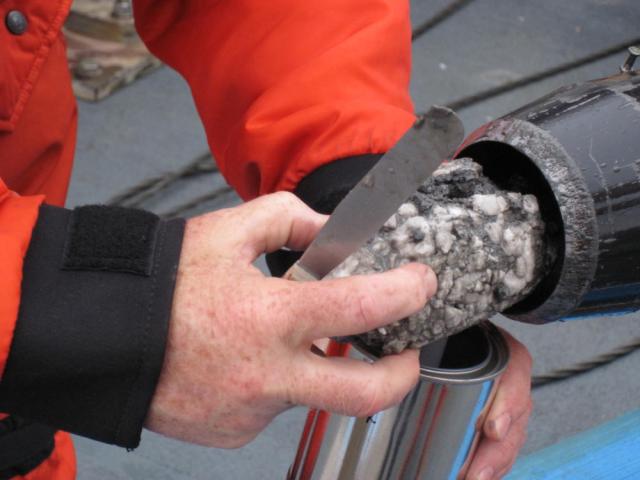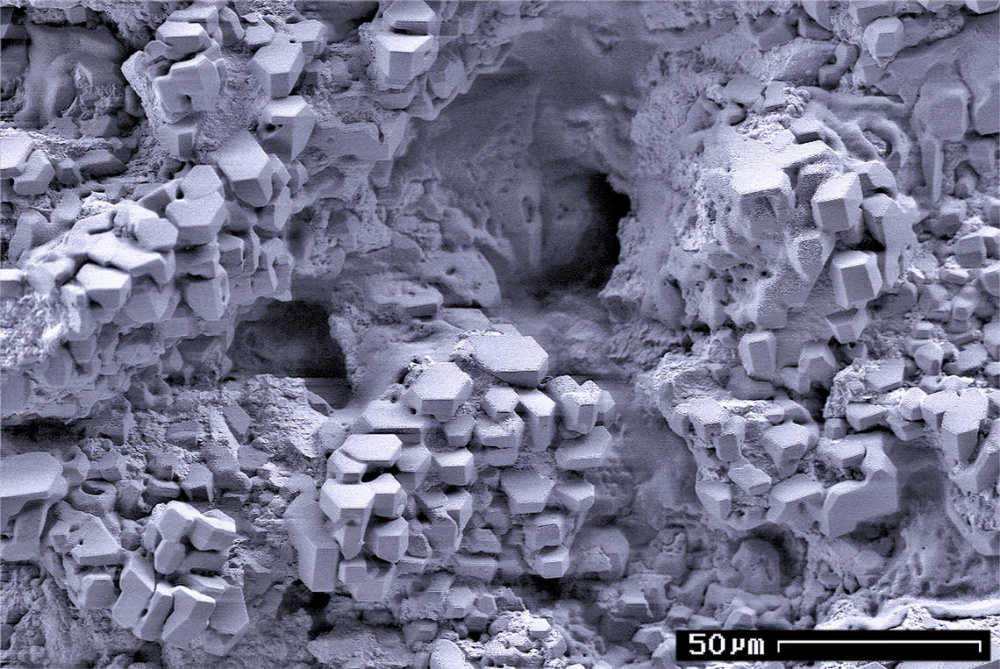
In 2010, the U.S. Geological Survey recovered white chunks of gas hydrate (methane ice) mixed with gray sediment a few feet below the seafloor in the Arctic Ocean at a water depth of about 8,000 feet. (Source: Helen Gibbons/USGS Pacific Coastal and Marine Science Center)
The Alaska North Slope could hold an estimated 58.8 trillion cubic feet (Tcf) of undiscovered, technically recoverable natural gas hydrate resources, according to an updated assessment by the U.S. Geological Survey (USGS).
The assessment follows a 2008 study that revealed an estimated 85 Tcf of technically recoverable gas resources could be within Alaska North Slope’s gas hydrates. The latest news comes after evaluation of more extensive 3-D seismic mapping, better data collection and more refined analysis.
“To date, there is no known commercial production of natural gas from gas hydrate formation and the commercial viability of gas hydrate reservoirs is not yet known,” USGS said in a statement Sept. 10. “This assumption is based on both limited field testing and numerical production models of gas hydrate-bearing reservoirs. No analysis was provided as to whether it would be profitable to produce these resources.”
Gas hydrates are crystalline solids that contain gas molecules trapped inside cage-like structures of water molecules. They are naturally occurring, forming in the presence of high pressures and low temperatures. Although gas hydrates can be problematic for oil producers, as they tend to cling to each other and increase in size causing blockages in pipes, they are also seen as another form of unconventional resource that could be developed if challenges are overcome.
“The study of gas hydrate as an energy resource is still an emerging field,” USGS scientist Tim Collett, lead author of the assessment, said in the statement. “The USGS has been conducting research on gas hydrates since the 1980s. Every time we conduct these assessments, we incorporate more and higher quality data, and our estimates become more precise.”
The USGS’ assessment examined technically recoverable resource potential in the North Slope of Alaska covering a 41,089-sq-mile area bounded by the National Petroleum Reserve-Alaska (NPR-A), Arctic National Wildlife Refuge, Brooks Range and the state-federal offshore boundary.
Gas hydrates below the permafrost were assessed, while free gas potentially trapped below the gas hydrate stability zone were not part of the study.
“Geochemical analyses of drill cuttings and core samples from wells drilled in the state of Alaska lands between the Canning and Colville rivers and within NPR-A indicate that the gas within the drilled and well log inferred gas hydrate accumulations is in part from thermogenic sources, with the thermogenic gas migrating from deeper sources, including known conventional oil and gas accumulations,” USGS said in the report.

“Thermal conditions conducive to the formation of permafrost and gas hydrates are believed to have persisted in the Arctic since the end of the Pliocene (about 2.58 million years ago),” the agency added. “In addition, most permafrost-associated gas hydrate accumulations probably developed from preexisting free-gas fields that originally formed in conventional hydrocarbon traps and were later converted to gas hydrates upon the onset of glaciation and cold Arctic conditions.”
About 27% of the undiscovered gas hydrate resources estimated mean of 53,796 billion cubic feet are within the Sagavanirktok Formation Gas Hydrate assessment unit (AU), 33% in the Tuluvak-Schrader Bluff-Prince Creek Formations Gas Hydrate AU, and 40% (21,511 BCFG) in the Nanushuk Formation Gas Hydrate AU, the report showed.
But the USGS cautioned that “given that relatively few wells have penetrated the expected gas hydrate accumulations in these three AUs, there is significant geologic uncertainty in these estimates.”
Recommended Reading
ProPetro Ups Share Repurchases by $100MM
2024-04-25 - ProPetro Holding Corp. is increasing its share repurchase program to a total of $200 million of common shares.
Baker Hughes Hikes Quarterly Dividend
2024-04-25 - Baker Hughes Co. increased its quarterly dividend by 11% year-over-year.
Weatherford M&A Efforts Focused on Integration, Not Scale
2024-04-25 - Services company Weatherford International executives are focused on making deals that, regardless of size or scale, can be integrated into the business, President and CEO Girish Saligram said.
Range Resources Holds Production Steady in 1Q 2024
2024-04-24 - NGLs are providing a boost for Range Resources as the company waits for natural gas demand to rebound.
Hess Midstream Increases Class A Distribution
2024-04-24 - Hess Midstream has increased its quarterly distribution per Class A share by approximately 45% since the first quarter of 2021.






